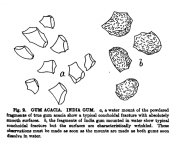Acacia senegal (gum)
(→information from USD 1918) |
|||
| Line 1: | Line 1: | ||
=Introduction= | =Introduction= | ||
| − | '' | + | =Macroscopic Entries= |
| + | {{Macroscopy | source=United States Dispensatory (1918) | ||
| + | | description=The most important of the gum-yielding Acacias is the official ''A. Senegal'' Willd. | ||
| − | + | This is a small tree rarely exceeding a height of 6 m., with a grayish bark, the inner layers of which are strongly fibrous, bipinnate leaves, dense spikes of small yellow flowers longer than the leaves, and broad pods containing 5 or 6 seeds. | |
| − | The | + | The gum of the acacias exudes spontaneously from the bark, and hardens on exposure; but incisions are sometimes made in order to facilitate the exudation. The gum is said also to be found immediately under the bark, where it is sometimes collected in regular cavities. It is formed within the plant by metamorphosis of the cells of the inner bark. The tissues involved are chiefly those of the sieve and the cambiform cells. While to some extent it is a natural change, yet it is usually looked upon as being in part a pathological production, as gummosus develops more largely upon the wounding of the trees. |
| + | }} | ||
| − | |||
| − | |||
=Microscopic Entries= | =Microscopic Entries= | ||
{{Microscopy | source=Schneider, A. (1921) The Microanalysis of Powdered Vegetable Drugs, 2nd ed. | {{Microscopy | source=Schneider, A. (1921) The Microanalysis of Powdered Vegetable Drugs, 2nd ed. | ||
Revision as of 20:47, 12 December 2013
Contents |
Introduction
Macroscopic Entries
|
Microscopic Entries
|
HPTLC Entries
Other Points of Interest
Cite error: <ref> tags exist, but no <references/> tag was found
